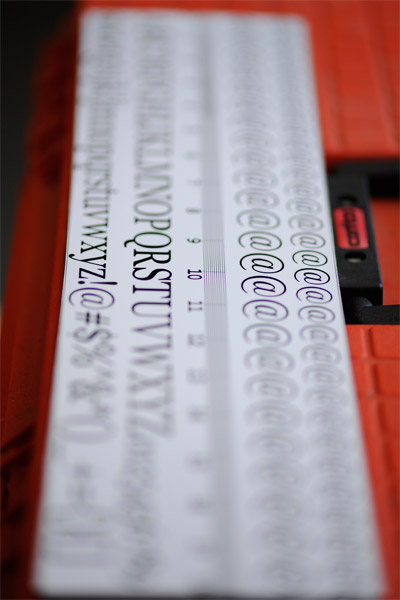
|

|

|

|

|

|

$220 SAVE $130 = 37.0% Western Digital 16.0TB Western Digital Ultrastar DC HC550 3.5-in… in Storage: Hard Drives
|

$500 SAVE $75 = 13.0% OWC 1.0TB OWC Atlas Pro SDXC V60 UHS-II Memory Card (2-Pack) in All Other Categories
|

|

|

|

|
Focus Accuracy—Diopter Adjustment
As regular diglloyd blog readers know, manual focus accuracy can be tricky, which gave me fits with the Nikon D3 (but not with the Canon EOS 1Ds Mark III). First, Nikon replaced the focusing assembly. But I still could not obtain accurate manual (eye) focus with lenses like the Zeiss ZF 100/2 Makro-Planar and several others. The fact that Nikon accepted my D3 for repair, and did replace the focusing system might is curious, since the repaired camera seemed to have the same issue as the original.
No issue with the Canon EOS 1Ds Mark III
By comparison with the D3, the Canon EOS 1Ds Mark III has never exhibited any manual focus inaccuracy, yielding spot-on manual focus by eye. The reasons for this are unclear, but several factors could be involved:
- The focusing screen in the 1DsM3 might simply be more optimal for manual focusing. It certainly seems easier to focus.
- The viewfinder of the 1DsM3 might be optically different in a way that makes it less sensitive to the diopter adjustment. In theory, the diopter adjustment should not matter (aside from eyestrain); the eyepiece images the image projected by the lens onto the internal camera ground-glass.
- The Canon EOS 1Ds Mark III viewfinder has 0.76X magnification with an eyepoint of 20mm. The Nikon D3 offers 0.70X with an eyepoint of 18mm. The 1DsM3 viewfinder seems easier to manually focus; these facts support that subjective impression.
- Because of the superior viewfinder magnification, diopter adjustment on the 1DsM3 seems easier, and therefore less prone to error. Attempts to adjust it were unambiguous: +0 was the best choice.
Resolving the mystery
Two Nikon D3 bodies with the Zeiss ZF 100/2 Makro-Planar
A friend brought his Nikon D3 over and we performed some controlled tests together. The test consisted of taking 10 frames with each camera, using the same lens (the Zeiss ZF 100/2 Makro-Planar). We each refocused completely for each frame. We tried this with a +0 diopter settings and also a minor deviation, each choosing our own variant.
Results
The results were consistent: a tiny error in the diopter adjustment was responsible for the gross focus error. We found that misadjustment by even the minimum “tick” away from +0 adjustment caused substantial error (some users will actually need something other than +0, the author’s vision is corrected to 20/20 with contact lenses).
The confounding factor is that I had always made the diopter adjustment on an outdoor scene in good light, choosing a diopter adjustment that seemed best—a bit hard to tell sometimes, but “surely a small difference would not matter”. It turns out that it does matter.
The target
The target on which the personal diopter adjustment judgment is made does matter: use a high contrast target, preferably one with lines as below (see below). The slightest deviation from perfect diopter adjustment causes the lines to go from thick to thin, which makes it much easier to find the correct diopter adjustment.

With a test target consisting of fine parallel lines (see below), I found that +0 was the optimal setting (for me). I had been using the bare minimum minus adjustment, based on what looked good on an outdoor scene—not accurate enough.
The tiny difference in the diopter adjustment made all the difference in focus accuracy, raising it from a ~20% success to ~80% success rate (eyes aren’t perfect). These figures are approximate, but were consistent between myself and my fellow tester. They were also consistent on both Nikon D3 bodies.
Actual pixels differences
Mouse over/out the image below to see the difference in focus accuracy at f/2. The focus difference might seem small until one realizes that f/5.6 - f/8 is required to regain sharpness at the “10” line! The absence of magenta/green color fringing is the easiest way to see where the actual plane of focus cuts.
The focus error is not just an issue for close-ups, see the infinity misfocus example in the Feb 2008 diglloyd blog.
Conclusions
Summary of findings:
- The diopter adjustment really does matter. Even being 1 “tick” off results in errors. The reason for this might be the eye “straining ” to accommodate.
- The grid lines of the target visibly change by being off just by 1 tick of the adjustment knob; thick black lines change into thin black ones or ones that can't be resolved by eye.
- Quick eye-based manual focusing results in some random errors, but not consistent backfocus (only), provided that the diopter adjustment is correct.
- Variation between the two testers was less than variation caused by incorrect diopter adjustment.
Reader Cecelia C found these conclusions helpful in resolving the focus issues with her Nikon D3—careful adjustment of the diopter setting solved the problem.



















